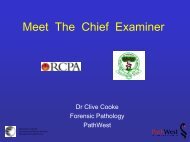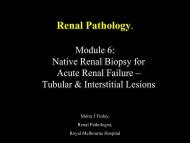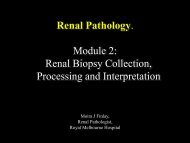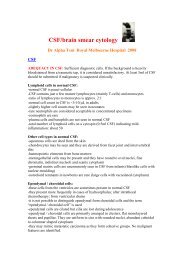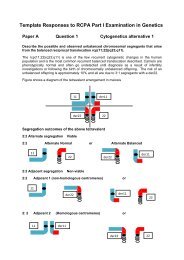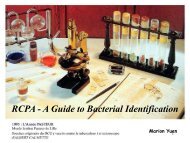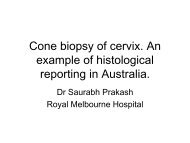Model Answers Microbiology Written examinations 2007 - RCPA
Model Answers Microbiology Written examinations 2007 - RCPA
Model Answers Microbiology Written examinations 2007 - RCPA
You also want an ePaper? Increase the reach of your titles
YUMPU automatically turns print PDFs into web optimized ePapers that Google loves.
<strong>Model</strong> <strong>Answers</strong> <strong>Microbiology</strong> <strong>Written</strong> <strong>examinations</strong><br />
Menu: Part 1, <strong>2007</strong><br />
Part 2, <strong>2007</strong><br />
Queensland Trainee paper, <strong>2007</strong><br />
Leave feedback<br />
Part 1, <strong>2007</strong><br />
Answer all 5 Questions. All Questions have equal marks<br />
Introduction:<br />
1. Each of these following questions was marked by two examiners each of<br />
whom is an experienced examiner and a Fellow of the <strong>RCPA</strong> in the discipline<br />
of microbiology. Each examiner was asked to provide a “model‟ answer to<br />
the Chief examiner and the “model answers” provided below are based on a<br />
combination of these answers from experts in the field who are also<br />
examiners. The answers were also reviewed by the Chief Examiner<br />
<strong>Microbiology</strong><br />
2. It is important to define your subject and to answer the question carefully and<br />
accurately<br />
3. If your writing is not easy to read try spacing out your words and leaving a<br />
line between the lines. You will not lose marks for underlining and ruling off.<br />
Etc. If your writing is truly indecipherable you should contact the CEX and<br />
the exam invigilator there is a college Policy on this issue and it is possible to<br />
arrange for an alternative method for submitting the answers provided this is<br />
arranged in plenty of time prior to the examination and you are prepared to<br />
bear the cost of using an alternative method.<br />
4. You must also answer each question ONLY for the time allotted. You will<br />
not get more marks for spending twice the time on one section. 5 questions,<br />
20 marks each, 4 sections/ question = 5 marks per section. If you miss one<br />
section out you are immediately down 5 points.<br />
5. You should also read the instructions to candidates provided in the<br />
examination room so that you are aware of the marking system for that<br />
examination. You must carefully note the number of questions to answer and<br />
the time (duration) of the examination. NOTE: not all <strong>examinations</strong> are the<br />
same, so be ready to read and understand the instructions for each (written)<br />
examination.
Question 1. Write short notes on the laboratory detection of:<br />
H5N1 Influenza A virus<br />
AmpC resistance<br />
Sensitivity testing of yeasts<br />
Detection of T. vaginalis<br />
<strong>Model</strong> <strong>Answers</strong> for Question 1 (Areas to cover):<br />
H5NI Influenza A virus<br />
Discuss: the best specimens for detection, and why, the safety aspects of testing for<br />
this organism, the role of point of care tests, definitive laboratory tests eg antigen<br />
detection, viral culture (appropriate cell lines) and identification of isolates, RNA<br />
detection<br />
What tests are available, how they are performed, sensitivity and specificity of each,<br />
turnaround times and usefulness<br />
Role of serology<br />
See PHLN document “Detection of Influenza”. influenza.pdf<br />
AmpC resistance<br />
When to suspect it<br />
Which organisms are involved?<br />
Where does it come from?<br />
Results with conventional sensitivity testing-disc, automated devices, other<br />
Definitive testing: phenotypic and genotypic<br />
Different screening methods especially disc diffusion and other methods for<br />
inducing the enzyme<br />
Technical details and interpretation of same (in considerable detail)<br />
Genotyping<br />
See attached document on Amp C
Sensitivity testing of yeasts<br />
Brief but comprehensive description of all methods used in diagnostic laboratories<br />
Macro broth<br />
Micro broth (sensititre)<br />
Disc diffusion (CLSI)<br />
Etests<br />
Others<br />
How to perform, how to interpret, standardisation, controls, limitations, and practical<br />
difficulties<br />
Differences between different organisms, different antifungals<br />
CLSI document on yeast sensitivity testing (reference and example pages attached)<br />
Article: Antifungal Susceptibility testing: New trends<br />
Detection of T vaginalis<br />
Specimens, transport and storage conditions, on the spot microscopy vv transported<br />
specimens<br />
Direct microscopy , wet films, permanent preparations, how performed, sensitivity,<br />
advantages and disadvantages<br />
Culture-methods, indications<br />
Non microscopic methods (molecular)<br />
Comments:<br />
This is a microbiology examination so a detailed discussion of the clinical<br />
presentation, treatment, importance of the organism and public health aspects is NOT<br />
required. Time spent on those issues will mean less time to specifically answer the<br />
question and therefore lower marks will be obtained.<br />
The introduction to the question above specifically states “write short notes on the<br />
laboratory detection of:”.<br />
Everything relevant to the laboratory detection should be considered including<br />
sample collection, specimen transport, methods of processing in the laboratory and<br />
the reasons why some methods are “better,” (used more frequently, automated, cost<br />
less, commercially available) and the advantages and disadvantages of each and the<br />
reporting and report comments, can, and should be considered in your answers
Question 2 Compare the advantages and disadvantages of:<br />
<br />
<br />
<br />
<br />
RTPCR and viral culture<br />
Chromogenic media and selective media<br />
Swabs versus fluid samples for examination for bacteria<br />
Serum versus plasma for antibody detection<br />
RTPCR and viral culture<br />
Confusion over whether RT means Real time or reverse transcriptase therefore you<br />
must define your topic and indicate what you are addressing if there is confusion.<br />
General discussion about PCR is acceptable<br />
PCR- Rapid TAT especially important when infection control public health<br />
intervention required. Detects non cultivable viruses. Can be used to detect dangerous<br />
viruses without the need for P3/4 facility, Sensitive, Transport and storage of<br />
specimens less important than fro culture, Initial set up is expensive, Easier to train<br />
staff in PCR techniques than those for viral culture, Problems with false positives and<br />
inhibitors resulting in false negative results, Can only detect specific viruses tested for<br />
. there is no isolate available for further characterisation or sensitivity testing<br />
although sequencing can reveal some known genes associated with resistance in some<br />
viruses eg CMV, HIV<br />
Viral culture: Slow, need to maintain cell cultures, CPE can be subtle or non specific,<br />
experienced staff needed to undertake viral cultures, increasingly hard to find. Cell<br />
lines prone to contamination, can detect many different viruses including novel<br />
strains, less sensitive but more specific although new PCR techniques to trawl<br />
samples for DNA/RNA have detected several new viruses recently that have not been<br />
identified in culture previously, Virus available for further characterisation eg typing,<br />
resistance testing and to enable fulfilment of Koch‟s postulates<br />
Chromogenic media and selective media<br />
Candidates need to show that they understand the difference between differential and<br />
selective media. Chromogenic media: commercial , less flexible, expensive. Useful<br />
in mixed culture where provisional ID only of pathogen may be sufficient. Advantage<br />
relates to ease opf plate reading and rapid provisional ID. Colour differences may be<br />
sublte, Some important organisms can not be differentiated eg klebsiella/enterobacter.<br />
Expensive if further ID still required. Selective media: often in house so flexible and<br />
cheaper, isolates always require additional ID tests. Some straines of bacteria may be<br />
inhibited.
Swabs versus fluid samples for examination for bacteria<br />
Swabs: Cheap and readily available.<br />
Usually easy to collect specimen. Easiy storage and transport. Only collects small<br />
superficial sample. Less suitable for anaerobic or fastidious organisms, Not suitable<br />
for AFB detection. Some swab types are inhibitory to some bacteria and other<br />
organisms. Easy to plate, Microscopy , quantitation can be problematic, culture<br />
results often reflect superficial colonising bacteria only.<br />
Fluids: Usually large sample from a normally sterile site. Requires invasive<br />
procedure to collect, Immediate processing required, Provides additional information<br />
eg cell count, crystals etc. All bacteria are potentially detectable. A concentration step<br />
may be required, may be abole to perform other tests eg PCR, viral culture. Isolates<br />
usually more significant than isolates from swabs.<br />
Serum versus plasma for antibody detection<br />
Need to know the difference between plasma (cell free blood with proteins and<br />
clotting factors) and anticoagulant. Serum, extracellular portion of blood after<br />
coagulation (cell free and protein free blood (clotted)). Plasma is preferred sample in<br />
biochemistry laboratories because of faster TAT, larger volume to test and easier to<br />
automate. One tube fits all. Serum is preferred for antibody tests. Plasma can not be<br />
used for agglutination or Complement Fixation tests. Plasma may be used in some<br />
EIA tests if they have been calibrated. NAA tests can be undertaken on plasma and<br />
serum
Question 3: Discuss the differences between:<br />
<br />
<br />
<br />
<br />
Virulence and pathogenicity<br />
Colonisation and infection<br />
S. aureus and MRSA<br />
Planktonic and sessile bacteria<br />
Virulence and pathogenicity<br />
Pathogenicity is the ability of an organism to cause disease due to structural and<br />
biochemical mechanisms. Pathogenic organisms have the ability to invade tissues and<br />
initiate infection. Involves both host and microbial factors. Pathogen requires ability<br />
to colonise, bypass host defences, invade deeper tissues. Due to the [presence of<br />
adhesions, resistance to phagocytosis, intracellular invasion and survival within cells,<br />
impairment of complement functions, lytic effect on PMN<br />
Virulence is the degree of pathogenicity within a group of organisms. Multifactorial<br />
microbial and host factors. Infectivity is the ability to initiate infection. Severity<br />
depends on the presence of virulence factors. These are substances produced by<br />
bacteria to harm the host. Eg exotoxins, haemolysins, lipases, elastases, proteases,<br />
alginate polysaccharides, antimicrobial resistance factors, leucocidin, hyaluronidase,<br />
streptokinase, staphylokinase, cytolysins, siderophores, protein M, TSST, PVL<br />
Virulence could be manifest in one host (eg immune suppressed vv another).<br />
Microbial virulence factors can be the target of effective immune responses eg<br />
antibody response demonstrating that host immunity influences virulence. Virulence<br />
factors may be used as vaccine antigens to reduce or negate virulence in certain<br />
microbes<br />
Colonisation and infection<br />
Colonisation requires attachment of bacteria via adhesions to receptors in host tissues,<br />
may be part of the normal flora, may be symbiotic with the host, may precede<br />
infection, examples of adhesions include: pili, fimbriae, lipoteichoic acid, protein F,<br />
examples of normal colonisation are skin, GI tract, upper respiratory tract<br />
Normal flora organisms colonise surfaces<br />
Infection is acquisition of a microbe by a host then invasion of the host by organisms<br />
with virulence factors to produce local or systematic disease. Ie there is presence of<br />
the organism, invasion and a host response. Infecting organisms penetrate the skin or<br />
mucous membranes by the production of invasions (spreading factors, hyaluronidase,<br />
collagenase, etc) and more extensive effects if exotoxins are produced.<br />
Clinical examples of infection compared with colonisation, normal flora compared<br />
with pathogens.
S. aureus and MRSA<br />
S. aureus: traditional pathogen sensitive to antibiotics, community and hospital,<br />
spectrum of disease virulence, treatment. Catalase pos, coag pos, gram positive<br />
coccus. Reservoir is anterior nares. Grows on non selective agar as golden colonies.<br />
Causes boils, food poisoning,(preformed toxin) endocarditis. Selective media<br />
including mannitol salt agar, salt broth, treat with flucloxacillin<br />
MRSA sub set of S. aureus. Resistance to beta lactams (and other classes). Mec A<br />
SCC, laboratory detection, hospital pathogen, virulence, nature of host, community<br />
strains caMRSA, PVL, treatment, infection control issues.<br />
Treat with vancomycin, linezolid, teicoplanin.<br />
Planktonic and sessile bacteria<br />
Planktonic bacteria are those that are suspended or growing in a fluid environment as<br />
opposed to those attached to a surface. Mobile, active metabolism, more sensitive to<br />
antibiotics, different DNA to sessile forms<br />
Sessile bacteria live on a surface in a community or biofilm. Reduced growth rate<br />
compared with planktonic bacteria, enmeshed in a matrix of extracellular polymeric<br />
substances, growth regulated by quorum sensing system. MIC much higher in old<br />
biofilms compared with planktonic bacteria. Antibiotics have difficulty penetrating<br />
biofilm and therefore difficult to eradicate.<br />
Examples IV lines, prosthetic valves, joints.
Question 4. Write short notes on:<br />
<br />
<br />
<br />
<br />
Norovirus detection<br />
Role of anaerobic blood cultures<br />
Flocked swabs<br />
Non cultivable bacteria<br />
Norovirus detection<br />
+ss RNA virus; Calciviridae, human calici virus distantly related to the other human<br />
calicivirus....sapovirus. 2 strains of Norovirus, genotype 1 and 2. Responsible for<br />
acute gastroenteritis. Nausea 9%, vomiting 69% and diarrhoea 66%, abdominal<br />
cramps 33% also headache, fever, chills reported. first recorded epidemic in 1968.<br />
Norwark virus. Epidemics occur in winter and spring and low background disease<br />
throughout the year. Often associated with hospitals, nursing homes, cruise ships,<br />
restaurant s and schools. Virus shed in vomitus and faeces. Faecal oral and vomitus<br />
oral eg alleged vomitus aerosol landing on food or fomites and then being consumed.<br />
In developed countries 50% population infected by 5 th decade. Acquired earlier in<br />
developing companies with poor sanitation. Gut virus receptor related to certain<br />
blood group antigens. Blood group B individuals are resistant to infection. RNA<br />
codes 3 ORF: ORF 1 encodes a non structural polyprotein that self cleaves to form 6<br />
structural proteins. ORF2 the capsid protein; ORF3 a minor structural protein.<br />
Diagnosis : RT-PCR of faeces or vomit. EM and IEM used in the past. Antigen<br />
based tests available but have low sensitivity and do not cover all human strains of<br />
norovirus probably due to antigenic variability/instability. (genotype 2 common<br />
strain in Australia<br />
Role of anaerobic blood cultures<br />
Past blood culture studies have shown rates of anaerobic bacteraemia of 10-15%.<br />
More recently this rate has fallen. ~5%. Finding anaerobes must be taken seriously<br />
as they can indicate important underlying primary infection or underlying disease. B<br />
frag = intraabdominal infection, F necrophorum + Lemmiere‟s disease or<br />
necrobacillosis with venoocclusive complications, clostridial sp and association with<br />
colonic cancer, gas gangrene. Often polymicrobial bacteria in gut disease.<br />
Automated systems detect anaerobes at similar rates<br />
Flocked swabs<br />
Used for 2 reasons; > nasopharyngeal cells cp cotton tipped swabs or NPAs, better<br />
detection of N gono and Chlamydia. Nylon, > absorbtive surface, non inhibitory<br />
Non cultivable bacteria<br />
Recent molecular tools suggest that non cultivable bacteria exist in many situations<br />
such as the gut. These organisms do not yet grow on defined media. An example is
Tropheryma whippelii the cause of whipples disease. This organisms was visualised<br />
in tissues but has not yet been cultured., identified using 16sRNA PCR. Interest in<br />
these organisms in chrons disease, inflammatory joint disease. T pallidum, C<br />
trachomatis are also non cultivable. Other reasons for inability to culture include<br />
prior use of antibiotics, dormant bacteria<br />
Question 5: Write short notes on<br />
Kohler illumination<br />
Gram‟s stain<br />
Use of a biological safety cabinet<br />
Disinfectants for use in the microbiology laboratory<br />
See attached paper for answers to all of these questions
<strong>Microbiology</strong> PART 2, <strong>2007</strong> <strong>Model</strong> answers<br />
Question 1, Marker 1<br />
What is the role of antenatal serology in modern medical practice and why?<br />
Roles of serology<br />
Routine screening<br />
At risk screening<br />
Diagnosis where risk of consequences<br />
When the infection is likely to have consequence for the foetus – eg contact with<br />
rash or rash-like illness in pregnancy. This is incorporated into the discussion of<br />
each of the specific infections.<br />
Diagnosis of acute disease<br />
Where interventions are available or where reassurance can be given that no foetal<br />
harm is likely e.g. EBV BFV RRV etc
General principles<br />
Routine vs selective<br />
The following factors should be taken into account when selecting a screening<br />
strategy:<br />
1. Detect infection<br />
Does the test detect potential foetal infection and damage?<br />
2. Assay<br />
Is there a sensitive and specific reliable assay available?<br />
3. Intervention<br />
Is there a safe and effective intervention strategy available if detected?<br />
4. Frequency<br />
Problems<br />
Does the infection occur at a frequency that has a cost benefit for the<br />
screening?<br />
Asymptomatic infections<br />
Poor positive predictive value<br />
Requiring further investigative actions<br />
Repeat serology/avidity etc<br />
Amniotic fluid examination<br />
Foetal blood examination<br />
Cord blood examination<br />
Often the true state of affairs remains unresolved<br />
Can generate angst for mother and family<br />
Termination as a result of not tolerating even minimal risk<br />
Psychological, Medicolegal, Ethical, Medical dilemmas<br />
Practical points<br />
Never base management decisions on a single test result<br />
Repeat tests preferably using a different method and on a second collection<br />
False positive IgM‟s are not that uncommon<br />
Serial sample testing important<br />
Avidity testing also may help – proportional to the maturation response of<br />
antibodies<br />
High avidity excludes infection in the previous 3- 4 months<br />
Low avidity usually BUT, not always, implies recent infection<br />
Stored serum samples at least for one year are important<br />
Examples<br />
Syphilis<br />
1. Detect potential foetal infection and damage
Primary, Secondary, Latent, Tertiary – Risk of foetal infection inversely<br />
proportional to stage<br />
2. Sensitive and specific reliable assay available<br />
EIA and other specific serology TPPA, FTA Abs WB<br />
RPR to monitor disease activity<br />
Note EIA false positives<br />
Note biological false positives in pregnancy<br />
Follow RPR to monitor treatment response<br />
3. Availability of a safe effective intervention strategy if detected<br />
Penicillin especially before 12 weeks as the damage to the foetus is<br />
immunological<br />
4. Occurs at a frequency that has a cost benefit for the screening<br />
Cost of caring for an infected infant high – recent cost benefit analysis in<br />
Australia means that women at risk from bisexual men,<br />
<br />
<br />
Rubella<br />
Capturing the appropriate population an issue – aboriginal population<br />
Need to attend antenatal care and have repeat testing if at risk exposures<br />
1. Detect potential foetal infection and damage - Primary infection CRS<br />
< 8 weeks – 90-100%<br />
8-12 weeks – 50%<br />
12-20 weeks – 20%<br />
>20 weeks < 1%<br />
Rubella reinfection 19 IU/ML = immune<br />
o If
2. Sensitive and specific reliable assay available<br />
Not generally recommended<br />
IgM may persist for weeks to months to years following infection<br />
IgA or avidity testing may be more helpful<br />
Recently recommending testing infants at birth (Massuchuses)<br />
3. Availability of a safe effective intervention strategy if detected<br />
Antibiotic therapy – spiramycin T1 and pyrimethamine and sulphadiazine<br />
T2 and T3<br />
Diagnosis of foetal infection – US and amniocentesis and PCR at least 4<br />
weeks after documented infection<br />
Treatment of newborn for 12 months following delivery to halt progressive<br />
disease (Chicago studies)<br />
4. Occurs at a frequency that has a cost benefit for the screening<br />
Pros and cons complex; Seroprevalence 14%<br />
Educative protocols in place<br />
Some recommend repeat testing after 1-6 months or at delivery to identify<br />
seroconversion<br />
HIV<br />
1. Detect potential foetal infection and damage<br />
Perinatal transmission<br />
No HIV embryopathy described<br />
1/3 of perinatal transmission occurs in utero<br />
2/3 of perinatal transmission occurs in post partum<br />
2. Sensitive and specific reliable assay available<br />
Screen with EIA<br />
Confirm with Western Blot<br />
May require repeat test if recent exposure or indeterminate WB<br />
3. Availability of a safe effective intervention strategy if detected<br />
AZT from 14-34 weeks gestation<br />
Mode of delivery – CS (IV AZT 3 hours before section +/- nevaripine)<br />
HIV viral load – proportional risk of transmission at delivery<br />
o V1 10000 9-29%<br />
ROM > 4 hours (x4 fold increase in risk)<br />
Avoidance of invasive procedures (foetal scalp electrodes, episiotomy etc)<br />
Recommend bottle feeding (x2 risk of breast feeding)<br />
Follow up with 6 weeks of AZT to infant and cotrimoxazole for 3 months<br />
Follow infant – t cell subsets, PCR, virus isolation, HIV ab<br />
4. Occur at a frequency that has a cost benefit for the screening<br />
Although low prevalence in population –<br />
o 50% of HIV + pregnant women are unaware of their HIV status<br />
o 66% of HIV + pregnant women have no risk factors<br />
Risk factors:<br />
o Recipients of blood product or human tissue prior to 1985<br />
o Past history of IVDU<br />
o Partner of IVDU or resident/partner for high prevalence area<br />
o Bisexual relationship<br />
o Seroconversion illness
Hepatitis B<br />
1. Detect potential foetal infection and damage<br />
High risk groups<br />
Areas of high prevalence<br />
Household contacts of carriers<br />
Multiple sexual partners<br />
Tattoos, body piercing<br />
If HBsAg negative offer vaccination post partum<br />
Ensure screening and vaccination of family members<br />
Sag pos+ eag - - vertical transmission 5-20%<br />
Sag+ eag+ - vertical transmission 70-90%<br />
90% of infected infants become chronic carriers<br />
2. Sensitive and specific reliable assay available<br />
Yes: HBsAg; if positive HBeAb HBeAg<br />
LFT‟s and DNA if abnormal LFT‟s<br />
3. Availability of a safe effective intervention strategy if detected<br />
No need for C/S<br />
HBIg (0.5ml) and HBV vaccine (0.5ml imi)<br />
Breast feeding: - although detectable HBV DNA in breast milk – no added<br />
transmission risk demonstrated<br />
4. Occurs at a frequency that has a cost benefit for the screening<br />
Note that universal screening recommended as earlier attempt at<br />
identifying a risk group was not successful<br />
Hepatitis C<br />
1. Detect potential foetal infection and damage<br />
If mother HCV Ab pos and HCV RNA PCR negative – prenatal<br />
transmission 0%<br />
If mother HCV Ab pos and HCV RNA PCR positive – prenatal<br />
transmission 0%<br />
Coinfection with HIV – prenatal transmission 9-45%<br />
Transmission proportional to RNA load<br />
2. Sensitive and specific reliable assay available<br />
Yes<br />
HCV Ab – but need to confirm with a second assay with different<br />
antigenic matrix:<br />
RIBA may be useful to sort out in determinates or discordant serology<br />
Also HCV RNA/PCR viral load<br />
3. Availability of a safe effective intervention strategy if detected<br />
No clear evidence re mode of delivery and reduction of perinatal<br />
transmission<br />
Breastfeeding: no increased risk of transmission demonstrated<br />
Most uninfected infants HCV Ab negative at 12 months<br />
Follow up infant HCV Ab at 12-18 months<br />
Or if concerned earlier HCV Ab and HCV RNA PCR<br />
If infected LFT‟s and HCV RNA PCR<br />
Refer for possible therapy (IFN and Ribaviron)<br />
4. Occurs at a frequency that has a cost benefit for the screening<br />
Detection allows evaluation of treatment in the mother post partum
CMV<br />
VZV<br />
HSV<br />
1. Detect foetal damage or well being of the mother<br />
Leading cause of congenital infection; (0.3- 2%) of live births<br />
Approx 6/1000 pregnancies<br />
Diagnosis: 40-50% risk of transmission<br />
Symptomatic disease 10% (normal 10%; sequelae 90%)<br />
Asymptomatic disease 90% (normal 90%: sequelae eg deafness 10%)<br />
2. Sensitive and specific reliable assay available – limitations<br />
Asymptomatic v infectious mononucleosis syndrome<br />
IgM EIA 75% sensitivity and specificity<br />
May persist for months or years after primary infection<br />
Reappear with reactivation or reinfection<br />
False positives – other herpes viruses, pregnancy, autoimmune disease<br />
Serial rise in antibody levels v seroconversion v avidity<br />
May require ultrasound (30-50% sensitivity; Amniocentesis PCR +/- foetal<br />
serology<br />
3. Availability of a safe effective intervention strategy if detected<br />
None effective for either prevention of transmission or for effective<br />
treatment of congenital CMV<br />
4. Occurs at a frequency that has a cost benefit for the screening<br />
Risk groups<br />
Day care workers – seroconversion 11% per annum<br />
Parents with child in day care – 20- 30% per annum<br />
General population – 2-3% seroconversion per annum<br />
1. Detect potential foetal infection and damage<br />
CVS<br />
20 weeks – isolated case reports – zoster in infancy<br />
2. Sensitive and specific reliable assay available<br />
Yes for wild disease<br />
No for past vaccination status<br />
VZVIgM; also VZV PCR for acute diagnosis<br />
3. Availability of a safe effective intervention strategy if detected<br />
Passive immunisation VZV IgG < 96 hours<br />
Acyclovir to protect mother from severe varicella zoster not necessarily<br />
the foetus<br />
T2<br />
Underlying lung disease<br />
Immunocompromised<br />
Smoker<br />
4. Occurs at a frequency that has a cost benefit for the screening<br />
Common – however 90 +% immune; increasingly likelihood of varicella<br />
vaccine immunity<br />
1. Detect potential foetal infection and damage
NA<br />
2. Sensitive and specific reliable assay available<br />
Limited probably to detection of discordant partners in pregnancy<br />
HSV positive male and HSV negative female at risk of primary HSV<br />
infection in pregnancy<br />
Risk when primary infection occurring at delivery – 50%<br />
3. Availability of a safe effective intervention strategy if detected<br />
Practice safe sex at time from 36 weeks<br />
4. Occurs at a frequency that has a cost benefit for the screening ?<br />
Parvovirus<br />
Detect potential foetal infection and damage<br />
Not teratogenic<br />
Foetal hydrops – intrauterine transfusion<br />
1. Sensitive and specific reliable assay available<br />
IgM –<br />
IgG – Immune status<br />
Recent infection ? recent infection, susceptible, immune<br />
Repeat in 2-4 weeks after exposure or if symptoms occur<br />
2. Availability of a safe effective intervention strategy if detected<br />
Foetal hydrops – intrauterine transfusion<br />
Ultrasound<br />
3. Occurs at a frequency that has a cost benefit for the screening<br />
Diagnosis of infection following contact or illness with rash during<br />
pregnancy<br />
Common non notifiable infection
Question 1, Marker 2<br />
What is the role of antenatal serology in modern medical practice and why?<br />
Role to allow intervention<br />
<br />
<br />
<br />
<br />
<br />
Opportunity to terminate pregnancy/counsel re possible outcomes of<br />
pregnancy<br />
Prevent transmission<br />
Prevent infection/sequelae of infection if transmission occurs<br />
Allow early therapeutic intervention/monitoring of infant<br />
Opportunistic screening of women who are presenting to health care workers<br />
Discussion points:<br />
<br />
<br />
<br />
Screening vs symptomatic<br />
Universal vs targeted<br />
Cost effective<br />
Timing of screening eg preconception/early „booking‟ bloods ~ 12 weeks +/-<br />
later in pregnancy<br />
<br />
Australia<br />
<br />
<br />
If no useful intervention or cost/benefit not favourable then screening not<br />
recommended. Confirmatory testing – may involve further cost, anxiety,<br />
procedures eg amniocentesis, foetal blood sampling – risks to pregnancy<br />
Hepatitis B surface antigen – passive and active immunisation at birth<br />
prevents > 95% transmission<br />
Rubella IgG – if non immune vaccinate post partum
Syphilis – treatment of mother and monitoring/treatment of infant<br />
HIV – treatment of mother and infant<br />
Hepatitis C (medicare rebate will now cover this) counsel/monitor<br />
infant/caesarean may reduce transmission<br />
Other countries<br />
Toxoplasma – France – monitor seronegative women in pregnancy, offer treatment if<br />
seroconvert<br />
Issues<br />
Screening for eg MCV, VZV, parvovirus, HSV 1 and 2<br />
<br />
Testing if symptomatic or exposure<br />
o<br />
o<br />
o<br />
Timing of exposure relevant<br />
Rash – parvovirus, VZV, Rubella<br />
Exposure eg VZV – VZIG
Question 3, Marker 1<br />
What do you consider the essential features of a microbiology laboratory<br />
information system? Describe the main features you would consider when<br />
choosing a new LIS and how would you ensure its smooth implementation?<br />
Candidates should be able to discuss 5-7 points well<br />
Essential features<br />
<br />
<br />
<br />
<br />
<br />
<br />
<br />
<br />
<br />
<br />
<br />
<br />
<br />
Data entry efficient: Screens, click through, ease of use, and enable paperless<br />
workflow<br />
Interface with machines<br />
Audit trails<br />
Expert rules: CAR, insert comments, suppress reporting<br />
On-line worksheets, validation and record of communications<br />
Tag pathogens: nosocomial, notification<br />
Antibiogram and other data extracts<br />
Management reports, epidemiology<br />
Autovalidation with blood cultures<br />
Data fields and c compliant with 15189 requirements<br />
Response time, IT architecture<br />
Vendor support<br />
Storage – in-house v commercial<br />
Implementation<br />
<br />
<br />
<br />
<br />
Evaluation process: operational IT architecture, IT and professional (practice)<br />
considerations<br />
Set up databases, dictionaries, codes and rules, plan and time line<br />
Test environment before going live<br />
Staff training
Test and verify interfaces, data transfer epidemiology reports and extracts<br />
System to make and track changes<br />
Verify data transfer<br />
Change management, benefit patient, physicians, lab staff<br />
LIS team or rep<br />
Objectives<br />
<br />
<br />
<br />
Operational efficiency<br />
Reduce errors<br />
Enhance patient care
Question 3, Marker 2<br />
What do you consider the essential features of a microbiology laboratory<br />
information system? Describe the main features you would consider when<br />
choosing a new LIS and how would you ensure its smooth implementation?<br />
Candidates should be able to discuss 5-7 points well<br />
Basic essential features<br />
<br />
<br />
<br />
<br />
<br />
<br />
<br />
<br />
<br />
Robust technical specification<br />
Referential integrity<br />
Security<br />
Resilience<br />
Traceability<br />
Auditable by ad hoc enquiry<br />
Capacity<br />
Speed<br />
Paperless<br />
Other essential features<br />
<br />
<br />
<br />
<br />
User friendly graphic interface<br />
User privileges commensurate with needs<br />
Flexible user configuration without the need to involve the vendor, e.g. users,<br />
facilities, work lists, reporting lists, report formats, comments, laboratories,<br />
referral laboratories, test codes, comment codes, organism codes,<br />
susceptibility panels, susceptibility suppression rules etc.<br />
Adequate patient identification and demographic fields
Automated barcode label generation<br />
Flexible interfacing to instruments and other peripherals<br />
Data accession from external databases, e.g. from clinical PMI<br />
Auditable free text lab user notes linked to specific lab numbers/tests<br />
Ability to scan and store requests to meet Medicare Australia requirements<br />
Multi-site capability with flexible pre- analytical systems for specimen<br />
accession and tracking<br />
Streamlined validation of data transfer from interfaced instrumentation<br />
Ability to trace user for each step in pre- analytical, analytical and postanalytical<br />
process<br />
Multi-step validation process including final pathologist validation<br />
Automatic fax capability for results<br />
Secure and verifiable transfer of results to external information systems with<br />
no corruption of date type or content<br />
Functional billing module to meet accountancy standards and Medicare<br />
Australia requirements<br />
System compliant with NPAAC standards<br />
System compliant with ISO quality system requirements<br />
User friendly and flexible search functions including the ability to search for<br />
bulk data satisfying user defined criteria.<br />
Automated notification of notifiable diseases<br />
Ability to notify infection control practitioners of relevant results<br />
Real time secure access to up to date validated laboratory information for<br />
clinical users preferably through a continuously updated application separate<br />
from the LIS and not effected by LIS scheduled or unscheduled downtime<br />
Desirable<br />
<br />
Electronic order entry with lab configurable essential fields, test rules and<br />
prompts<br />
Implementation<br />
<br />
<br />
Chose the right system<br />
Planning and training with adequate resources including dedicated staff
Question 4, Marker 1<br />
Laboratory notification of MRSA has been proposed. Present your reasons for and<br />
against this proposal.<br />
Background<br />
MRSA endemic in hospitals in eastern Australia since 1980‟s<br />
<br />
<br />
o<br />
o<br />
o<br />
o<br />
o<br />
o<br />
Healthcare associated (HCA) MRSA is predominately EA- MRSA<br />
(ST93-MRSA-III) – multi- resistant<br />
EMRSA-15 (UK) (ST22-MRSA- IV) recently introduced – resistant to<br />
cip or cip/ery and urease negative<br />
Prevalence still increasing in NSW and Vic but decreasing in QLD<br />
SA level intermediate<br />
WA low level but EMRSA-15 perdominates<br />
Other overseas strains also seen some of which have marked epidemic<br />
potential<br />
Increasing consensus that HCA MRSA can be controlled best with screening<br />
and isolation and the standard measures including standard hand hygiene are<br />
inadequate<br />
Therefore, evidence exists for widely varying rates of HCA MRSA throughout<br />
Australia and for opportunities to optimise MRSA IC measures. Notification<br />
would provide for benchmarking and monitoring of progress in efforts to<br />
combat the nosocomial MRSA problem.<br />
New strains of MRSA have appeared in the community since the late 1980‟s<br />
in WA and mid 1990‟s elsewhere. The major strains are:<br />
<br />
o<br />
o<br />
o<br />
ST1-MRSA-IV (WA-1) _ PVL neg<br />
ST30-MRSA-IV (WWSP1/2, southwest Pacific, Oceania) – PVL pos<br />
ST93-MRSA-IV (QLD) – PVL pos<br />
Many other strains are also seen indicating active acquisition of SCCmec by<br />
multiple lineages
For<br />
<br />
<br />
<br />
<br />
<br />
<br />
<br />
This epidemic in gaining pace throughout Australia and ST93 in increasing<br />
rapidly and will probably overtake ST1 as the predominant strain<br />
PVL – give explanation<br />
PVL positive strains associated with furunculosis, and occasionally<br />
necrotising pneumonia, osteomyelitis (+septic thrombophebitis and PE in<br />
children), septicaemia. Fatal cases occur in young otherwise healthy children<br />
and adults.<br />
MRSA bacteraemia is a major issue as is S. aureus bacteraemia in general and<br />
is now being studied nationally (ANZCOSS). Thousands of cases are thought<br />
to occur annually with a mortality of approx. 30% (probably higher for<br />
MRSA)<br />
All of the above provides rationale for notification and intervention<br />
Intervention in CA-MRSA has occurred successfully in Denmark and is now<br />
being tried in WA. Contact tracing (household contacts) – increased hygiene,<br />
mupirocin, phisohex or chlorhexidine washes and follow up screening<br />
Establish baseline and benchmark<br />
Identify problem areas for intervention<br />
Evidence for successful HCA intervention strategies based on targeted<br />
screening and isolation is available and increased hand hygiene has also<br />
apparently been successful as an intervention in some settings<br />
Reduction of HCA MRSA has shown to reduce morbidity and mortality and to<br />
be cost effective in terms of overall health budget (through reducing<br />
morbidity, mortality and LOS)<br />
Establish population rates of CA MRSA<br />
Provide guidance to practitioners at a local level (empiric therapy etc.)<br />
Allow for community intervention<br />
Against<br />
<br />
<br />
<br />
<br />
Potential for stigmatisation of institutions based on MRSA rates<br />
Perception that intervention may be associated with increased costs<br />
Insufficient resources may be provided to labs or service providers to make the<br />
program work successfully<br />
Increased litigation may follow at the instigation of unscrupulous legal firms
Question 6, Marker 1<br />
List the samples that you would examine for fungi. Include how and why you<br />
would do this and when you would undertake sensitivity testing and referral to a<br />
reference laboratory.<br />
Samples<br />
Skin<br />
Scraping<br />
Hair<br />
Nails<br />
Biopsy tissue<br />
Respiratory<br />
Sputum<br />
Induced sputum<br />
Bronchoscopy specimens<br />
Aspirates<br />
Rarely pleural effusions<br />
Ear Swabs<br />
Sinus swabs include – tissue<br />
Urinary tract<br />
Urine catheters<br />
Renal disease<br />
Gastrointestinal<br />
Rare need<br />
Genital tract<br />
High vaginal swabs
Eyes<br />
Corneal scrapings – fungal keratitis<br />
Aqueous vitreous humour<br />
Tissue biopsies of any kind<br />
E.g. disseminated disease<br />
Brain<br />
Adrenals<br />
Thyroid<br />
Blood cultures<br />
Candidemias or fungemias<br />
How and why<br />
Media<br />
SAB (+ chlor, gent) 25-30C<br />
SD (SAB + cycoheximide) = MYCOSEL or (actidione) + (chlo + gent) 25-<br />
30C<br />
DTM = (chlo + gent + cycl) 25-30C<br />
SAB without antibiotics (may use for tissues from sterile sites)<br />
Chromogenic agar<br />
Dixons or overlay with olive oil for M.furfur from blood and occas skin but<br />
generally not indicated as microscopy sufficient from skin – 37C<br />
Set up in tubes to prevent drying as media held 3-4 weeks<br />
Avoid opening lids unless growth to prevent contamination<br />
Sporing for microscopy<br />
OA<br />
SACHs<br />
PDA – slide cultures/species etc<br />
CMA<br />
Basic techniques<br />
Macroscopic description of colonies<br />
Colour – surface reverse etc<br />
Appearance<br />
Microscopy from sample<br />
Hyphae – hyaline<br />
Hyphae – pigmented – T.nigra and other demateaciuos fungi<br />
Spores<br />
Yeast cells<br />
Pseudohyphae<br />
Copper pennies (Chromo) – SAB 28<br />
Spaghetti meat ball – M.f<br />
Microscopy of colonies<br />
Microconidia<br />
Macrocondidia<br />
Chlamydospores<br />
Other techniques<br />
Dimorphism demonstration: Mycelial conversion at 28 to Yeast at 37<br />
Exoantigen test – Histoplasmosis<br />
Differential temps of incubation<br />
Canavanine to speciate Cryptococcus – gattii v neoformans: association with<br />
HIV and prognosis
Bird seed – to confirm Crypto<br />
Ectoag test e.e. confirmation of culture Histoplasmosis esp when dimorphism<br />
difficult<br />
Vitek or API if not conclusive for yeast identification<br />
Details<br />
Skin and subcutaneous infections<br />
Specimens<br />
Scraping<br />
Hair<br />
Nails<br />
Biopsy tissue<br />
Diseases:<br />
Superficial: Pityriasis Versicolor (Malazzesia, Tinea Nigra) – Dixons<br />
Cutaneous: Dermatophytes – onychomycosis, tinea capitus and tinea<br />
<br />
corporis/cruris/pedis<br />
Subcutaneous: Sporo, Chrom, opportunists (Coelomycetes etc) traumatic<br />
implantation<br />
Collection:<br />
Scrapings, clippings, hair – adequate specimen an issue<br />
Microscopy<br />
calcofluor white/Evans blue in glycerol KOH, Calcofluor, - hyphae<br />
(allows terbinafine on PBS), spaghetti and meatballs = Malazessia furfur<br />
Culture media: SAB, SD, DTM<br />
Incubation 28C<br />
Duration 3 weeks<br />
Identification<br />
Edothrix, Ectothrix<br />
Anthropophilic, Zoophilic, Geophilic – management/source of infection<br />
Infection control issues<br />
New innovations: PCR<br />
Subcutaneous infections:<br />
<br />
<br />
<br />
<br />
Sporo – S.schenkii (dimorphism)<br />
Chromoblastomycoses<br />
o Cladiophilaophora grows on clclo 37<br />
o Fonseca<br />
Systemic infections with skin manifestations<br />
Often grow on the MCS blood agar at 37C e.g Fusarium<br />
Respiratory<br />
Respiratory<br />
Grow on routine bacto plates – normal flora: SAB (ABS) 25-30C, SD 25-<br />
30C + BHI (ABS0 (35)<br />
<br />
<br />
<br />
<br />
<br />
Nocardias on BHI<br />
Aspergillus spp, Scedospoium prolificans apiosperman<br />
Cryptococcus sensitive to cycloheximide<br />
Note lab safety issues: white fluffy fungi esp from resp tract but other<br />
tissues as well- arthroconidia of Coccidioides etc lab hazard<br />
DFA/silver staining/toluidine blue/PCR with quantification on respiratory<br />
specimens in immunosuppressed patients who have ground glass<br />
appearance suggestive of PCP (NB also stain with calcoflur)
Urinary tract<br />
Urine catheters/Renal disease<br />
Mainly candida – standard urine set up<br />
Germ tube<br />
Gastrointestinal<br />
Rare need<br />
Genital tract<br />
Mainly Candida – standard genital set up<br />
Correlate with microscopy<br />
Intractable vaginitis – may require speciation and sensitivity testing e.g.<br />
glabrata<br />
Tissue biopsies of any kind<br />
SABS (no Abs) SAB (Abs_ 25-30C, SD 25- 30C, BHI 25- 30C<br />
e.g. disseminated disease, brain, adrenals<br />
NB Zygomycetes – don‟t grind – non viable<br />
Blood cultures<br />
Liquid blood culture media (BacT Alert – good for mould and Candida)<br />
Lysis centrifugation<br />
Non-culture methods<br />
18S RNA PCR<br />
Galactoma Nan and other assay for Aspergillosis – monitoring function x<br />
2 weekly<br />
Susceptibility testing<br />
Often susceptibilities – predictable<br />
Relatively new – only just standardised<br />
Difficulties<br />
Inoculum preparation<br />
End point reading<br />
Fresh 24 H culture on SAB<br />
Methods<br />
CLSI – standardised guidelines – methods for yeast and moulds<br />
Difficult to do if only occasional<br />
Yeasts<br />
o Broth dilution M27-A2 standard for yeasts<br />
o RPMI<br />
o 24 hour reads<br />
o Trailing endpoints<br />
o Breakpoints for 24 and 48 hours<br />
o Numerical score 1 -4<br />
Commercial products:<br />
o Sensititer<br />
• AMB<br />
• FLU<br />
• ITRA<br />
• KETA<br />
• 5FC<br />
• VORI<br />
• POSI<br />
• CAS
o Disc diffusion<br />
• M$$-P standard for yeasts<br />
• For Candida species<br />
• Fluconazole (25ug) and Voriconazole (1ug)<br />
• MH glucose and MB<br />
Moulds<br />
o Yeasts easier than moulds<br />
o Broth dilution M38-A<br />
o RPMI 1640 glutamine<br />
E Strip<br />
o End points often difficult to read<br />
o Trailing ……..<br />
Neosensitabs<br />
Indications<br />
Unusual fungi where susceptibility less difficult to predict – difficulties with<br />
breakpoints<br />
Epidemiological purposes to accumulate invitro knowledge and correlation<br />
within vivo response<br />
Candida spp where prior imidazole therapy and possibility of resistance<br />
developing or selection of innately resistant Candida e.g. C.krusei<br />
Genital tract – glabrate and non response to imidazole<br />
Synergy voriconazole and terbinafine<br />
Non response to treatment<br />
Candidemias – especially non albicans (possible SDD or R to fluconazole)<br />
options: echinocandidin; caspofungin, ?voriconazole, posiconazole (esp<br />
Mucor)<br />
When to refer<br />
<br />
<br />
<br />
<br />
<br />
<br />
Sterile site isolate – difficult to identify<br />
e.g. non sporing<br />
Where fungus may be a laboratory hazard and appropriate facilities<br />
unavailable<br />
Confirm sensitivities and perform synergy testing<br />
Use of newer modalities – presence in histology or microscopy but culture<br />
negative e.g pan fungal PCR<br />
Specialised serological tests e.g galactoma Nan in immunosuppressed patients
Question 10, Marker 1<br />
Multi resistant M tuberculosis (XDR) is being increasingly isolated world wide.<br />
Define XDR and discuss the detection and laboratory implications of the emergence<br />
of XDR mycobacteria.<br />
Definitions<br />
<br />
<br />
Drug resistant TB – One first line drug<br />
Multidrug resistant TB (XDR) – Resistant to INH+Rif AND fluroquinolones<br />
+ kanamycin, amikacin or capreomycin (ie resistant to both first and second<br />
line drugs)<br />
Brief overview<br />
XDR epidemiology (up to 10% of MTB in Russia, India, China) emergence in<br />
<br />
<br />
<br />
<br />
Detection<br />
<br />
<br />
<br />
<br />
<br />
<br />
Africa, Iran and United States<br />
Rates in Australia<br />
Risk factors for acquisitions<br />
Previous treated TB, inappropriate treatment (see WHO guidelines), HIV<br />
coinfection, poor compliance, poor nutritional state, low socioeconomic status<br />
Mortality increase<br />
Clinical suspicion – previous treated TB, travel to or from an endemic region,<br />
clinical failure of standard regimes, HIV infection<br />
Standard laboratory detection and identification of MRB – ZN of sputum<br />
smears, Aura mine/Rhodamine, decontamination, culture in a liquid media,<br />
confirmation by standard phenotypic methods or molecular detection<br />
Phenotypic methods are more likely to be used in regions where the organism<br />
is prevalent.<br />
Growth characteristics and ZN appearance in broth, Nitrate, Niacin, Semi<br />
quant catalase, NAP, Pyruvate/glycerol growth, Tween 80 hydroslysis,<br />
Pyrazinamidase<br />
Molecular identification or detection, either from an isolate or from a clinical<br />
specimen<br />
o DNA-DNA hybridisation<br />
o IS6110 PCR detection<br />
Susceptibility testing
o<br />
o<br />
o<br />
Agar dilution – Middlebrook 7H11. Traditional method. Results<br />
expressed as resistance rations MIC test divided by MIC control<br />
Broth method – growth inhibition – Bactec, MGIT<br />
Molectlar detection of mutations in resistance associated genes. E.g.<br />
INH- katG, inhA, kasA, Rifampicin – rpoB, Streptomycin – s12,<br />
pyrazinamide – either phenotypic detection of pyrazinamidase or<br />
pncA, ethambutol embB<br />
Laboratory implications<br />
<br />
<br />
<br />
<br />
<br />
<br />
<br />
<br />
<br />
<br />
Safety and compliance with Australian standards<br />
XDR is a risk group 3 organism<br />
To be handled in a PC 3 laboratory – define<br />
Staff need appropriate training and experience<br />
Staff need BCG if Mantoux negative, regular CXR<br />
Dedicated space and equipment<br />
Increased testing, typing of isolates<br />
Liaison with Public Health<br />
Standardised methods and awareness of current WHO definitions and<br />
requirements<br />
Participation in an appropriate QAP
Question 10, Marker 2<br />
Multi resistant M tuberculosis (XDR) is being increasingly isolated world wide.<br />
Define XDR and discuss the detection and laboratory implications of the emergence<br />
of XDR mycobacteria.<br />
Answer<br />
XDR TB: detection and laboratory implications<br />
<br />
<br />
<br />
<br />
<br />
<br />
<br />
Drug resistant TB = isolate of MTB resistant to one of the 1 st line anti TB drugs;<br />
isoniazid, rifampicin, pytazinamide, ethambutol and streptomycin<br />
Multi drug resistant TB (MDR-TB) = isolate resistant to at least isoniazid and<br />
rifampicin<br />
Treatment for MDR TB patients use of 2 nd line drugs for greater than or equal to<br />
12 months<br />
MDR TB patients whose isolates are resistant to any fluoroquinolone and<br />
resistant to at least on 2 nd line injectable drug (amikacin, capreomycin or<br />
kanamycin) have been classified as extensively drug resistant (XDR-TB)<br />
(revised definition from WHO task force Oct 2006). An earlier definition of<br />
XDR TB was MDR TB + resistant to greater than or equal to 3 of the 2 nd line<br />
drugs. 2 nd line drugs (SLD‟s) include aminoglycosides, capreomycin,<br />
fluorquinolones, thiomides, cycloserine, para-aminosalicyclic acid<br />
The rationale for the revised definition: (i) protocols for drug<br />
susceptibility testing of fluoroquinolones and injectable anti<br />
TB agents are established and there is good inter laboratory<br />
agreement; there is less agreement for the other SLD‟s and<br />
none whatsoever for cycloserine, (ii) the fluoroquinolones<br />
and injectable agents are the most potent SLD‟s and form the<br />
corner stones of most MDR TB treatment regimes and (iii)<br />
are often the only SLD‟s available in developing countries.<br />
Losing the FQs and the injectable agents means losing the most potent and least<br />
toxic options for the 2 nd line therapy<br />
XDR TB is now documented in many countries – highest known rates in Eastern<br />
Europe and Asia<br />
XDR TB is a microbiological diagnosis – documenting the emergence of XDR<br />
TB requires the collection and processing of adequate specimens for culture and<br />
susceptibility testing, prior to institution of therapy.<br />
If a patient cannot produce expectorate sputum, sputum<br />
induction should be performed with necessary protection of<br />
supervising HCW e.g sputum collection and cough-inducing<br />
procedures should be performed in negative pressure ventilation<br />
rooms. HCWs should wear respiratory protection when present<br />
in room or enclosure in which cough-inducing procedures are<br />
being performed on patients who my have infectious TB. These<br />
high-risk patients should also be managed appropriately before<br />
and after specimen collection to limit cross-infection to other<br />
patients and to HCWs.
Collection of tissue for those with extrapulmonary disease e.g.<br />
lymph node, bone omentum<br />
Smear results reported within 24 hours<br />
All specimens should be inoculated in broth-based culture<br />
system +/- onto solid media<br />
<br />
<br />
<br />
Susceptibility testing should be performed by a reference laboratory<br />
The DSTs must be performed using a broth-based culture system so that results<br />
are available promptly. Using these methods, laboratories should aim to report<br />
MTBC DST results within an average of 15-30 days from the time of the<br />
original specimen reception. The DSTs themselves can generally be completed<br />
within 7-14 days of obtaining the initial M. tuberculosis isolate from the primary<br />
cultures<br />
Drug susceptibility tests must be performed in the following circumstances:<br />
All initial isolates of M. tuberculosis<br />
Isolates from patients who remain culture-positive after 3<br />
months of treatment<br />
Isolates from patients who are clinically failing treatment: or<br />
An initial isolated from a patient relapsing after previously<br />
successful TB treatment. 14,15<br />
Second line drug susceptibility tests should be performed on:<br />
<br />
<br />
<br />
<br />
<br />
<br />
All MDR TB isolates (i.e. isolated demonstrating isoniazid and rifampicin<br />
resistance)<br />
All isolates demonstrating resistance to greater than or equal to 2 first line drugs<br />
and<br />
Isolates from patients experiencing severe adverse reactions to first line agents<br />
Laboratories performing susceptibility testing must be involved with an external<br />
quality assurance program<br />
Laboratories performing susceptibility tests should ideally have PC3 facilities<br />
At this time – WHO does not recommend testing of thioamides, cycloserine or<br />
PAS as reproducibility of testing is poor. Testing of a fluoriqyubikibe (cuori ir<br />
ifkixacub) then moxifloxacin if cipro/oflox is resistant, an aminoglycoside<br />
(amidacin and/or kanamycin) and capromycin
Question 11, Marker 1<br />
Describe, with examples, the full laboratory investigation of CSF obtained by<br />
lumbar puncture.<br />
Specimen arrives in laboratory<br />
<br />
<br />
<br />
Next<br />
<br />
<br />
<br />
<br />
Check name and details on sample match the request slip<br />
Macroscopic appearance<br />
o<br />
o<br />
o<br />
Is it clear?<br />
Is it bloodstained?<br />
• all tubes evenly bloodstained – subarachnoid haemorrhage<br />
more likely<br />
• blood staining decreases from tube 1 to later tubes – traumatic<br />
tap more likely<br />
Turbid – meningitis more likely xanthochromias<br />
Record volume of CSF (prefer at least 1 ml)<br />
If possible leave a tube for any PCR work which may be required (usually<br />
tube 4)<br />
Take sample of fluid with sterile pipette from each of tubes 1-3 and examine<br />
under the microscope in a counting chamber with cell grain e.g. (cell count)<br />
??????????<br />
In a traumatic tap, no of RBC‟s usually decreases in each successive tube<br />
taken.<br />
In meningitis, little difference between each tube
Normal cell count
Common CSF findings<br />
Viral<br />
Meningitis<br />
Bacterial<br />
Menignitis<br />
Cryptococcal<br />
meningitis<br />
TB<br />
meningitis<br />
Viral<br />
encephalitis<br />
Protein Glucose Cells Gm<br />
stain<br />
Bacterial<br />
culture<br />
Comments<br />
No or No Predominately Neg Neg Can do<br />
Slightly<br />
Lymphs<br />
enterovirus<br />
raised<br />
(some pdys<br />
PCR<br />
Raised<br />
Raised<br />
Raised<br />
No or<br />
raised<br />
day 1-3)<br />
Decreased May be pos,<br />
predominately<br />
pdys<br />
No or<br />
decreased<br />
Predominately<br />
lymphs<br />
Decreased Predominately<br />
lymphs<br />
No<br />
Predominately<br />
lymphs<br />
May be<br />
positive<br />
May be<br />
pos (Abs<br />
suggested)<br />
Neg Neg Can do<br />
India ink<br />
stain &<br />
CSF<br />
crypto AG<br />
Neg<br />
TB<br />
culture<br />
slow often<br />
6-8 weeks<br />
Can do<br />
AFB often<br />
neg TB<br />
PCR or<br />
LCX<br />
Neg Neg Can do<br />
HSV PCR<br />
<br />
Bacterial antigens no longer done – poor sensitivity and specificity.<br />
Extra tests<br />
Rarely useful unless abnormal protein/glucose/cell count<br />
<br />
<br />
<br />
<br />
<br />
<br />
<br />
<br />
<br />
<br />
crytpococcal antigen<br />
India ink stain (Cryptococcus)<br />
TB PCR/LCX<br />
AFB stain – rarely positive, need a lot of cells<br />
TB culture (6-8 weeks)<br />
HSV 1 & 2 PCR<br />
Enterovirus PCR<br />
JC virus PCR<br />
Meningococcal PCR<br />
Syphilis serology e.g. RPR, PTHA
Question 11, Marker 2<br />
Describe, with examples, the full laboratory investigation of CSF obtained by<br />
lumbar puncture.<br />
General points<br />
<br />
<br />
<br />
<br />
<br />
<br />
Emphasise how the nature and extent of testing is dictated by information<br />
about the patient:<br />
Importance of reading the history given<br />
Necessity of obtaining more history or speaking directly to the clinician, if<br />
indicated, both on receipt of specimen and when early results are available<br />
(microscopy, protein, glucose) as this may direct further investigations.<br />
Discuss the tests which are routinely performed<br />
Discuss testing which might be performed at the discretion of the<br />
microbiologist. (Perhaps discuss what testing in not indicated or is of limited<br />
benefit in some situations)<br />
Indicate how to prioritise testing when sample volume is limited.<br />
Microscopy<br />
<br />
<br />
<br />
Routine cell counts and interpretation of these<br />
Investigation of abnormal cells – eosinophils, cells with abnormal morphology<br />
Visual detection of organisms (include dark field microscopy for spirochaetes)
Organism identification<br />
Bacteria<br />
<br />
<br />
<br />
<br />
Fungi<br />
<br />
<br />
<br />
Viruses<br />
<br />
<br />
<br />
<br />
Choice of media, conditions of culture<br />
Non-cultural detection of bacterial infection<br />
o Ag detection<br />
o PCR<br />
Tests for tuberculosis<br />
o AFB staining<br />
o Culture<br />
o PCR (discuss methods)<br />
o (Chemical tests eg. adenine deaminase)<br />
Tests for syphilis<br />
o Especially critical evaluation for evidence of neurosyphilis<br />
Tests for Cryptococcus<br />
o Testing and significance of Ag detection<br />
o Serial CSF testing in evaluation of success of therapy<br />
Testing for other fungi e.g. dimorphic fungi<br />
CNS aspergillosis and other invasive mycoses<br />
Culture<br />
Noncultural methods especially PCRs<br />
Test selection for meningitis, encephalitis<br />
Special testing:<br />
o HIV – viral load<br />
o Testing in travellers e.g. arboviruses<br />
o Tests in immune-compromised patients e.g. EBV infection, JC virus<br />
o Testing for SSPE<br />
Parasites<br />
Diagnosis of CNS toxoplasmosis, cysticercosis, amoebic meningoencephalitis,<br />
African trypanosomiasis, angiostrongyliasis etc<br />
Prions<br />
Safety considerations
Mock exam Queensland trainees <strong>2007</strong><br />
General points:<br />
1. It is important to define your subject and to answer the question carefully and<br />
accurately<br />
2. If your writing is not easy to read try spacing out your words and leaving a<br />
line between the lines. You will not lose marks for underlining and ruling off.<br />
etc<br />
3. You must also answer each question ONLY for the time allotted. You will<br />
Not get more marks for spending twice the time on one section. 5 questions,<br />
20 marks each, 4 sections/ question = 5 marks per section. If you miss one<br />
section out you are immediately down 5 points.<br />
Question 2: Write short notes on:<br />
LGV Lymphogranuloma venereum<br />
Streptococcus gallolyticus<br />
Serological methods for the detection of deep seated mycoses<br />
The hazards of rain water tanks<br />
<strong>Answers</strong><br />
Lymphomgranuloma venereum:<br />
LGV is a sexually transmitted disease. It was originally described in 1833 by<br />
Wallace . Synonyms include Lymphopathia venerea, tropical bubo, climatic bubo and<br />
lymphgranuloma inguinale. It is caused by serovars L1, L2 and L3 of C trachomatis.<br />
It enters via skin breaks or abrasions or it crosses the epithelial cells of mucous<br />
membranes. It enters the lymphatics and multiplies within the mononuclear<br />
phagocytes in the regional lymph nodes.<br />
While transmission is mainly sexual fomites and laboratory accidents have been<br />
reported to cause disease.<br />
LGV occurs in 3 stages .<br />
Stage 1 is the formation of a painless herpetiform ulcer at the site of entry .<br />
Stage 2 is characterised by lymphadenopathy and constitutional symptoms. Including<br />
fever, headache, nausea, vomiting and arthralgias Suppuration occurs later and the<br />
nodes may coalesce. Clinically they can be confused with cat scratch disease and TB.<br />
Histological appearances are said to be diagnostic.<br />
Stage 3 occurs years after the initial infection and may present as rectal stricture or<br />
genital elephantiasis. Organisms are rarely present at this stage.
Extragenital inoculation sites also produce regional lymphadenopathy.<br />
LGV is endemic in Northern Australia. And internationally is found in East and West<br />
Africa, India, Southeast Asia, South Caribbean. There have been recent outbreaks in<br />
Europe associated with MSM<br />
Symptoms resolve completely with appropriate treatment but death can occur in<br />
unresolved tertiary illness from associated symptoms.<br />
Incubation period is 3-21 days, secondary stage occurs after 10-30 days<br />
Risk factors include unprotected sexual intercourse from an infected individual, anal<br />
intercourse, prostitution, residing in an endemic area<br />
Lab studies are usually unhelpful. The Frei was an intradermal skin hypersensitivity<br />
test that is no longer available. CF testing sensitivity is 80% for LGV, a titre of 1/16<br />
is suggestive and a changing titre may be diagnostic. MIF for the L serovar is<br />
diagnostic if the titre is 1:512, PCR is superior if it is available. Serology for syphilis<br />
should be undertaken as the patient may have other STD‟s.<br />
Doxycycline is the drug of choice for treatment in a dose of 100 mg bd for 21 days.<br />
Infection confers no immunity against future infection<br />
Contacts should be examined and patients counselled to use safe sex practices.<br />
References:<br />
CDC fact sheet: http://www.cdc.gov/std/lgv/STDFact-LGV.htm<br />
Streptococcus gallolyticus<br />
Strep bovis/Strep equinus is a large bacterial complex including different species<br />
frequently isolated from humans and animals.<br />
Strep bovis has been separated in to 3 different biotypes correlated with genetic<br />
differentiation. S bovis biotype 2, S gallolyticus S macedonicus and S waius form a<br />
single DNA cluster separated in to 3 different sub species. They are delineated by<br />
different biochemical traits, limited DNA-DNA relatedness and divergent 16SrDNA<br />
sequences.<br />
In 1977 Klein reported a strong association between S bovis bacteraemia and colonic<br />
cancer.<br />
S gallolyticus is gram positive non motile, non sporulating, in pairs or short chains.<br />
Catalase is negative. Alpha or non haemolytic on blood agar, tellurite neg, and<br />
hydrolyses aesculin but does not grow on 6.5% NaCl and is PYR neg. They are<br />
group D streptococci.<br />
S gallolyticus is a mannitol hydrolysing strain and has tannase and gallate activity (<br />
decarboxylate gallic acid to pyrogallol and hydrolyse methyl gallate (tannase<br />
activity)). It was previously identified as S bovis biotype 1 and has been associated<br />
with endocarditis and colonic cancer. It is also found in marsupial stool including<br />
koala, kangaroo, brushtails and possums. There are 3 subspecies which can be<br />
separated by various biochemical tests.
Serological methods for detection of deep seated mycoses.<br />
1. List of deep seated mycoses. Candida sp, paracoccidiomycosis,<br />
histoplasmosis, zygomycosis including mucormycoses eg mucor, rhizopus,<br />
phycomycoses , aspergillosis. The type of mycosis will depend on the<br />
geographical region as some strains are very location dependent.<br />
2. Occurrence: Many of these infections occur in immunocompromised patients<br />
so the detection of IgM and Ig G antibodies is unreliable even if there were<br />
good antigens available to detect antibodies produced against these organisms.<br />
3. Serology is defined as the detection of antibodies or antigens in serum<br />
4. Commercial serological tests available: Candida antibodies latex<br />
agglutination) , galactomannin (detecting aspergillus antigen EIA),<br />
Histoplasma antibodies (CF), western blot,<br />
Microbial hazards associated with use of rain water tanks<br />
Airborne microbes and chemicals can enter rainwater tanks via water collection<br />
processes either directly from the atmosphere or indirectly by leaching of materials<br />
from water collection surfaces animal excreta, debris and organic waste can also<br />
accumulate. Biofilm will form when the concentration of dissolved organics falls<br />
below 25mg/L. these develop complexity in time and they may assist in removing<br />
contaminants but there has been little work undertaken to examine this. There is<br />
current research starting to examine this issue.<br />
Microbes found in water tanks are likely to survive because of the lack of inhibiting<br />
substances, eg chlorine, the absence of filters and the leaching of bird and animal<br />
excreta which may contain enteric bacteria such as salmonella, campylobacter and<br />
parasites such as Giardia, cryptosporidium<br />
Also risk of breeding of mosquitoes spreading dengue, malaria, RRV, BF, other<br />
arbovirus infections.<br />
Please leave feedback<br />
See next page
FEEDBACK<br />
Did you find this mock examination helpful?<br />
Please take a few minutes to complete an online survey by following the link<br />
below:<br />
http://www.surveymonkey.com/s.aspx?sm=XiNssreXTNnuGuH51_2fG9Fg_3d_3d




